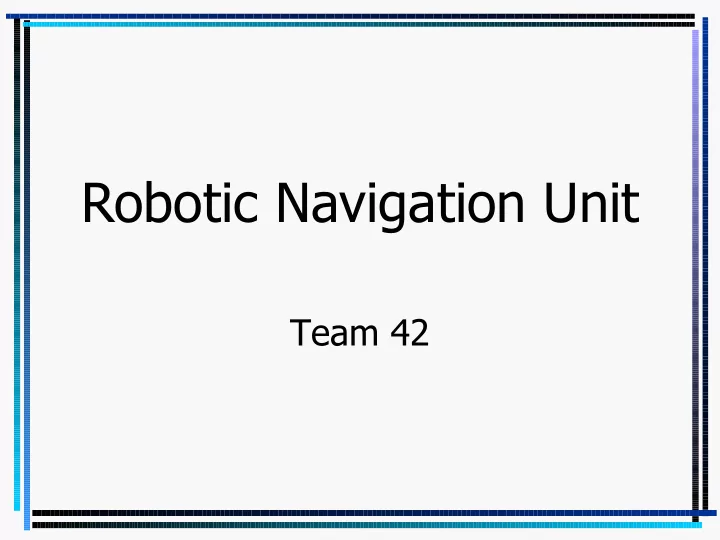

Robotic Navigation Unit Team 42
Robotic Navigation Unit • Dr. Crassidis – Faculty Mentor • Antonija Soldo – Team Leader/EE • Aneta Rozwadowska - EE • Andrew Fishbaugh - ME • Ian Kunsch - ME • Michael Oswald - ME • Stephen Byrne - ME • Vered Talmor - EE 2
Outline • Design Objective • Background • Development Stages • Project Overview – Description – Subsystems – Operation • Analysis – Mechanical – Electrical • Schedule 3
4
Design Objectives • Objective – Non-GPS mapping system – Autonomous and Self-contained – Navigate through 2-D area – Retrieve data to a computer – Stage 1: Record path – Stage 2: Intelligent Navigation • Scope – Budget: $2000 – Timetable: Demonstrate in May 2004 – Flat area (2-D) – Robust for three months of testing 5
Background • Sponsor – Intelligence Community – Need for low cost, non-GPS navigational unit – Need to map terrain • MIMNS (Miniature Inertial Measurement Navigation System) – Non-GPS – Inexpensive – Developed @ RIT – Outputs analog acceleration 6
Project Overview: Development Stages • Stage 1 (Scope): – MIMNS Interface – Motion Control – Obstacle Avoidance – Troubleshooting • Stage 2 (Optional): – Intelligent Navigation – Map Environment 7
System Overview H-bridge Batteries Microcontroller Ultrasonic Sensors Motors MIMNS cube Ultrasonic Sensor Infrared Sensors H-bridge 8 Servo Motor
Project Overview: Operation • TE – Transit Enable Ultrasonic sensor Ultrasonic sensor Ultrasonic sensor TE RS TE RS TE RS • RS- Receive Signal Trigger Echo (Echo) • DUR5200 I/O Ports Capture/Compare register Ultrasonic Sensor • NMIH-0050 MSP430 00 – Fwd Memory (Flash) Processor 01 – Left 10 – Right H-bridge 11 = Back 8 Channel 12 bit ADC I/O Pins / PWM generator • GP2D12 Infrared Sensor IR IR NMIH-0050 NMIH-0050 MIMNS H-Bridge H-Bridge • MSP430F449 – Microprocessor DC Motor 1 DC Motor 2 9
Analysis: Electrical TI-MSP430 Microcontroller • Low Power requirement • Low power consumption • 12 bit, 8 channel A/D • 60kB flash memory • 2048b RAM • 48 I/O • 125ns instruction cycle time • FET 10
Analysis: Electrical Sensors • Ultrasonic: DUR5200 – Obstacle Avoidance – Navigation Tools – Range: 4cm – 340cm – Digital Output – Low Power Consumption • Infrared: GP2D12 – Immediate Obstacle Avoidance – Range: 0 – 40cm – Analog Output 11
Analysis: Mechanical Specifications • Speed/Acceleration: 1.8m/s • Agility • Ground Clearance • Run time: ~1 hour • Weight: ~10 lbs • Power • Gearing • Frame: Aluminum 12
Project Overview: Initialize System Flowchart Read ADC, get Set up an interrupt MIMNS data, store it to trigger ADC every in the memory ~500m sec. No obstacle Check Bubble Continue moving L6 Obstacle L5 too L4 L7 close No L3 Begin return path Check sequence and look Environment for new paths L8 1 or more New good L2 path directions L9 Find best L1 direction 180 180 Adjust robot to Robot face best Bubble - sonar range (red arc) direction Environment Check Range (blue arc) Move forward 13
Analysis: Anticipated Challenges • Sensors – Accuracy – Blind spots – False positives • Navigation – Algorithm – Integration into control software • Micro Controller – Programming – Memory Usage – Compiler 14
Schedule Mar 2004 Apr 2004 May 2004 ID Task Name Duration 7/3 14/3 21/3 28/3 4/4 11/4 18/4 25/4 2/5 9/5 16/5 1 Purchase Components 5d Research Microcontroller Operation 2 15d and Programming 3 Test DC Motors, H-bridge 5d 4 Test Senors 15d Test A/D Converter; 5 15d MIMNS interfacing 6 Construction of Chassis 15d 7 Research PCB 15d Final Assembly and addition of 8 20d electronics Testing of mobile unit; 9 20d Implementation of obstacle avoidance Optional: Adding features and 10 implement complex navigation 25d algorithm 11 Any assembly changes 49d 12 Write final report 54d 13 CDR, Report due 0d 15
QUESTIONS ?????
Recommend
More recommend